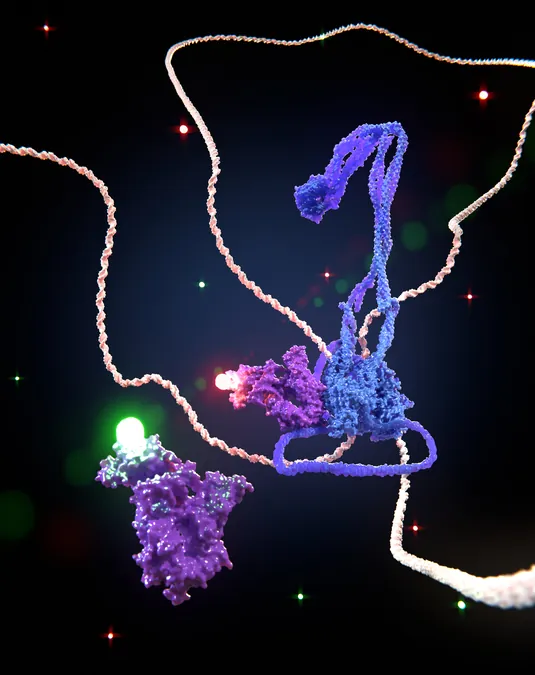
Revolutionary Discovery: DNA Motors Can Change Direction, Challenging Established Scientific Beliefs!
2025-01-16
Author: Yu
Groundbreaking Discovery About DNA Motors
In a groundbreaking study, scientists from Delft University of Technology, the University of Vienna, and the University of Lausanne have made a remarkable discovery about the protein machines responsible for shaping our DNA, revealing that these Structural Maintenance of Chromosomes (SMC) motors can actually switch direction. Previously, it was believed that SMC motors only moved in one direction, a notion that has now been overturned. This exciting new finding, published in the prestigious journal Cell, is pivotal in enhancing our understanding of how these motors influence our genome and regulate gene expression.
Implications of the Discovery
First author Roman Barth explains the implications of this discovery, stating, "Cells need to quickly adapt to changing conditions such as food intake, alcohol consumption, or temperature fluctuations. To effectively turn genes on and off in response to these changes, cells utilize SMC motors acting like switches to connect different segments of DNA."
Unique Properties of SMC Motors
What sets SMC motors apart is their reliance on exploring various segments of DNA to find the right points to connect, given that they do not inherently know which regions to link. They begin working at one site on the DNA, shaping it into loops until they reach a stopping point. The innovative research from Delft University indicates that these motors have the capacity to switch their direction of movement, allowing them to manipulate DNA from both sides.
Metaphor of a Gearbox
Delft professor Cees Dekker, who oversaw the study, explains this phenomenon using the metaphor of a car's gearbox: "This discovery is akin to a manual transmission that allows a vehicle to move forward or backward. We even identified a 'gear lever' in the cohesin SMC motor protein, specifically a protein subunit named NIPBL."
Technical Achievements in Visualization
Utilizing a state-of-the-art, custom-built microscope, researchers were able to observe individual proteins on single strands of DNA, a substantial technical achievement in itself. Barth elaborated, "A single cell harbors millions of proteins, while the human body comprises trillions of cells. The capability to isolate and visualize these proteins at a nanometric scale—100,000 times thinner than a human hair—is a major feat in nanotechnology."
Medical Implications of SMC Motor Function
Understanding how SMC motors function could have significant implications for medical science. Barth suggests that this knowledge might illuminate pathways to understanding and potentially remediate various diseases such as cancer and neurodegenerative disorders: "Conditions like neurodegenerative diseases can stem from improperly regulated genes during the earliest stages of pregnancy. There are known severe disorders, such as Cornelia de Lange syndrome, directly associated with the malfunctioning of SMCs, where these motors may fail to switch properly within embryonic cells."
Resolution of Scientific Controversies
This study resolves earlier controversies within the scientific community regarding the operation of SMC motors, which had been the subject of conflicting theories. Some studies argued that SMCs were uni-directional, while others suggested simultaneous pulling from both sides. With this new research, Barth asserts, "The commonalities discovered among SMC motors will help streamline and focus future research in this field. We can move forward without the need for a unique mechanism for each kind of SMC protein, accelerating the translation of this knowledge into practical applications in medicine."
Future Prospects in Genetic Medicine
As we venture into this exciting territory of genetic research, the implications for biotechnology and pharmaceutical development appear promising. Researchers and healthcare professionals are now keenly interested in how these findings might soon be translated into treatments that could revolutionize our approach to genetic conditions. Stay tuned, because this discovery could change the very fabric of genetic medicine!


 Brasil (PT)
Brasil (PT)
 Canada (EN)
Canada (EN)
 Chile (ES)
Chile (ES)
 Česko (CS)
Česko (CS)
 대한민국 (KO)
대한민국 (KO)
 España (ES)
España (ES)
 France (FR)
France (FR)
 Hong Kong (EN)
Hong Kong (EN)
 Italia (IT)
Italia (IT)
 日本 (JA)
日本 (JA)
 Magyarország (HU)
Magyarország (HU)
 Norge (NO)
Norge (NO)
 Polska (PL)
Polska (PL)
 Schweiz (DE)
Schweiz (DE)
 Singapore (EN)
Singapore (EN)
 Sverige (SV)
Sverige (SV)
 Suomi (FI)
Suomi (FI)
 Türkiye (TR)
Türkiye (TR)
 الإمارات العربية المتحدة (AR)
الإمارات العربية المتحدة (AR)